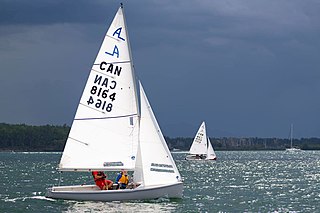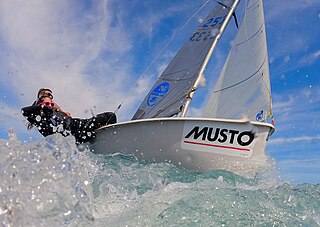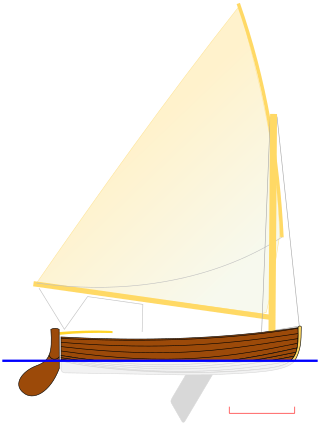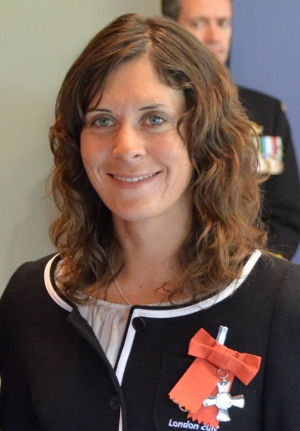
Dinghy sailing is the activity of sailing small boats by using five essential controls:
The Mirror is a type of popular sailing dinghy with more than 70,000 built.

Dinghy racing is a competitive sport using dinghies, which are small boats which may be rowboats, have an outboard motor, or be sailing dinghies. Dinghy racing has affected aspects of the modern sailing dinghy, including hull design, sail materials and sailplan, and techniques such as planing and trapezing.

The Albacore is a 4.57 m (15 ft) two-person planing dinghy with fractional sloop rig, for competitive racing and lake and near-inshore day sailing. Hulls are made of either wood or fiberglass. The basic shape was developed in 1954 from an Uffa Fox design, the Swordfish. Recent boats retain the same classic dimensions, and use modern materials and modern control systems.

The Wayfarer is a wooden or fibreglass hulled fractional Bermuda rigged sailing dinghy of great versatility; used for short 'day boat' trips, longer cruises and for racing. Over 11,000 have been produced as of 2016.

The 470 (Four-Seventy) is a double-handed monohull planing dinghy with a centreboard, Bermuda rig, and centre sheeting. Equipped with a spinnaker, trapeze and a large sail-area-to-weight ratio, it is designed to plane easily, and good teamwork is necessary to sail it well. The name comes from the boat's length of 470 centimetres.

The Optimist is a small, single-handed sailing dinghy intended for use by young people up to the age of 15.
Jack Holt, OBE was a prolific designer of sailing dinghies. His pioneering designs of dinghies using plywood did much to popularise the sport of sailing in the period immediately following World War II.

The Fireball is a British sailing dinghy that was designed by Peter Milne as a one-design racer and first built in 1962.

The Lark is a two-person, non-trapeze sailing dinghy, designed in 1966 by Michael Jackson. All Larks are made of glass-reinforced plastic (GRP). The Lark is a one-design class which leads to very close racing.

The International 14 is a British racing sailboat, crewed by two sailors. The class was established in 1928.

The Merlin Rocket is a 14 foot (4.3 m) dinghy sailed in the United Kingdom. It is an active class, now with over 3800 boats built.
Ian Douglas Ben Proctor was a British designer of boats, both sailing dinghies and cruisers. He had more than one hundred designs to his credit, from which an estimate of at least 65,000 boats were built. His pioneering aluminium mast designs also revolutionised the sport of sailing.
Phil Morrison is a British boat designer and racer rendered notable by the success of his many designs in many classes since 1967 as well as his own distinguished yacht racing career.
Peter "Spud" Rowsell (1943-2021) was a yachtsman and boatbuilder based in Exmouth, Devon, England. Amongst many racing successes, Rowsell won the Merlin Rocket Class Championships at Abersoch Wales in 1978, crewed by Jon Turner, with a series of results which have not been surpassed by any later Champion of the Class. Rowsell was in partnership with Phil Morrison as Rowsell Morrison for about 15 years.
Pwllheli Sailing Club is a yacht club in Pwllheli, Wales, founded in 1958. Over the years its clubhouse has moved several times, and it has also become an organiser of national and international yachting and dinghy sailing events.

Burghfield Sailing Club is an inland sailing club located close to the town of Theale in Berkshire near Reading in the south of England. The club and lake are easily seen from the M4 motorway as the westbound lane approaches Junction 12. BSC was one of the first Clubs in the UK to be awarded RYA Champion Club status.

Bill Lee is the designer of noted ocean racing yachts, and one of the founders of the Santa Cruz school of boatbuilding. Known to many as the Wizard, Lee's designs achieved notoriety in the 1970s, with Chutzpah and Merlin having won the Transpacific Yacht Race from Los Angeles to Honolulu many times. Merlin set and held the course record between 1977 and 1997, making the 1977 crossing in only 8 days, 11 hours and 1 minute.

The Twelve Foot Dinghy was designed by George Cockshott, an amateur boat designer from Southport, England in response to a 1912 design contest. It became the first one-design racing dinghy to achieve international recognition. The class was granted the 'International' status by the IYRU in 1919 and remained this status until 1964 when it was revoked by the same authority. The class was selected as the dinghy class for the Olympics in 1920 & 1928. In 1924 the French wanted to use an alternate French design.

Joanna Ayela Aleh is a New Zealand sailor. She is a national champion, a former world champion, and an Olympic gold medallist.













